After a week of exploring MacTown, Kamille and I were in for a magical treat at New Harbor. A short, thirty minute ride in a helicopter brought us out to a world like no other. After flying over the expanse of white ice interrupted only by the flat topped icebergs and surrounded by jagged peaks, we saw the little orange and blue tents in a sea of jagged, rugged, broken-up ice that signaled our field camp, New Harbor.
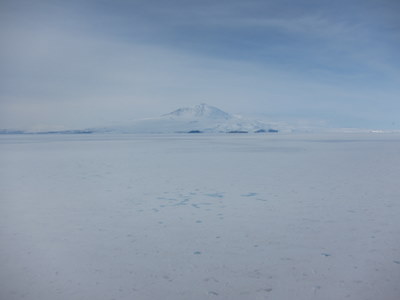
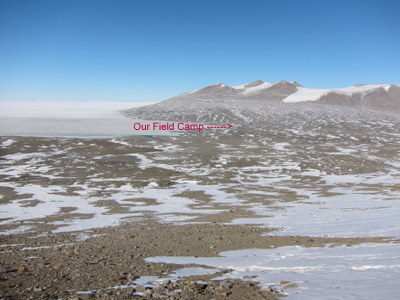
Upon touchdown, our team, which had already spent one week here, hurried to meet us and our resupply of 15 5-gallon water jugs, numerous boxes of food, and various extra pieces of science or SCINI equipment. As we carried everything away, Julie and Kevin climbed in the helicopter which carried them back to McMurdo for a week of diving and preparing holes on their own.
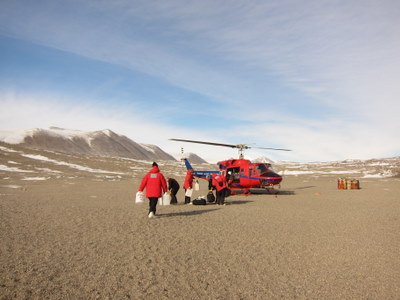
Room was made for the food in an underground ice box and we got a quick tour of the double-wide Jamesway that our team was sharing with another science group. There was a back room with 10 cots which mainly housed the other science team – a group that had 2 months out here to study fossils and tracks in the sediments of the seafloor. Stay tuned for their upcoming story and WATER DROP adventures.
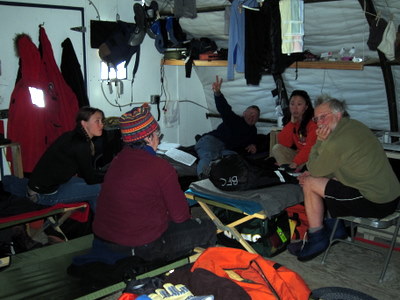
This “dark, sleeping area” was connected to the second Jamesway by a hallway decorated with Big Reds on one side and laptops and computer equipment on the other side. This was our indoor work area.
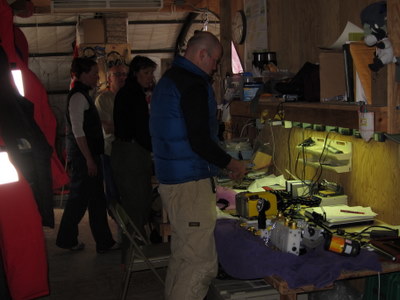
This also led to the main “living area” which housed a heater with two huge pots of “cleaning” water, a stove, a counter with kitchen appliances, dishes, pots and pans, and two cabinets stocked with food.
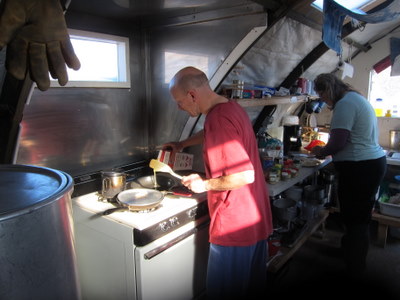
A big square table took up the center of the room and provided the perfect place for eating delicious, home-cooked breakfasts, lunches, and dinners!
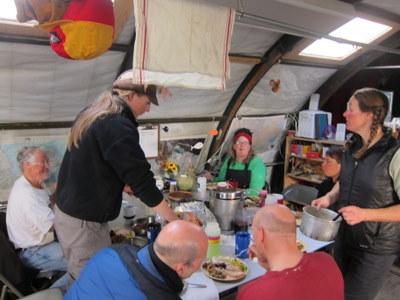
A real refrigerator stood in one corner, a water jug in another, and there were two sinks with tubs to wash our hands and dishes in. Electricity was provided by solar panels and a wind turbine about 50 feet away, phone service was in place, and at first we had wireless Internet connection. Various carpenters, electricians, and communication teams had been flown in at the beginning of the season to set all of this up for us. At the end of the season, they would return to disconnect or disassemble everything.
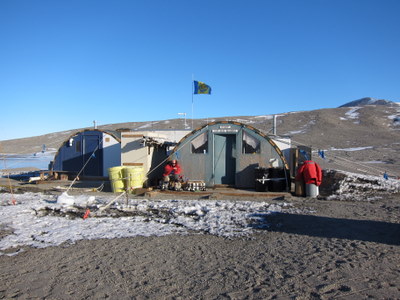
What should we do about water though? It’s heavy and we consume and use copious amounts of it for drinking and cleaning. Drinking water had been flown in from McMurdo with multiple helicopter flights.
Water for washing hands and dishes, however, was created on site by melting huge blocks of snow or ice. Being in pristine Antarctica, we could also not simply dump our dirty water so we used miniscule amounts of water to wash dishes and hands, and dumped all “grey” water in big grey water barrels, which helicopters had to fly back out to McMurdo.
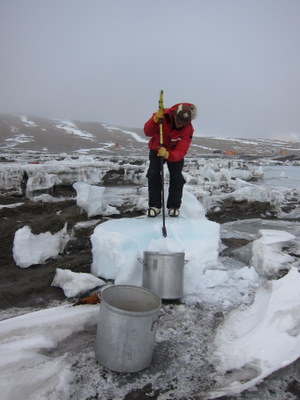
Outside we also had a bathroom like no other. At first glimpse it had four walls, a roof, a urinal, and two Styrofoam toilet seats. A deeper probe showed that the urinal and one of the seats led to a big barrel of “waste water” while the second seat simply covered an ordinary bucket lined with plastic bags. Being so remote and environmentally conscious of not leaving a trace, we had to fly out all of our waste – separated in true McMurdo fashion. Urine went in one barrel while the more solid waste went a separate direction and into its own container. It took a little thinking, but we quickly got the hang of jumping from one seat to the next to take care of our business.
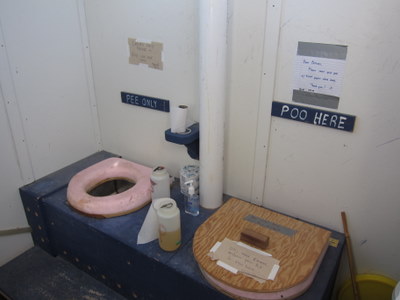
Besides the Jamesway, the power station, and the bathroom, our camp consisted of a few storage sheds, a little field laboratory, and 8 mountaineering tents which our group had set up as their sleeping area. With extra-warm sleeping bags and fleece liners, nights were warm though sleep was difficult due to a complete lack of darkness. Could you sleep if it never got dark?
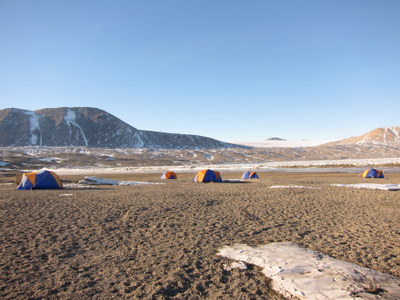
Though we had a warm kitchen and a “bathroom” and we had arrived in helicopters, we were essentially “car camping” on the mainland of Antarctica! The next time you go camping, think of how similar your style of camping is to that of us researchers working down here in a field camp in Antarctica! Is there anything you could do to be more environmentally friendly?
Leaving the main camp area, Kamille and I joined our group and immediately got to work, immersing ourselves in an amazing world of ice sculptures and melting puddles, brittle stars and scallops, endless skidoo and ATV hauls, and numerous successful SCUBASelf Contained Underwater Breathing Apparatus and SCINI missions.
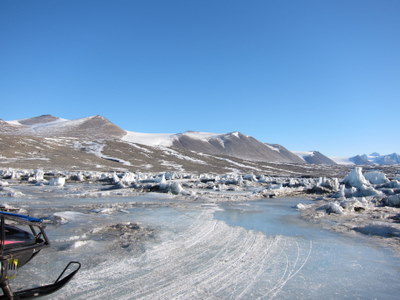
Following a ¼ mile “ice raceway” that our team had made through the world of ice sculptures, our skidoo took us to our work space, another Jamesway but one out on the ice instead of on the brown land. In this 15 foot by 40 foot house, our divers had their SCUBASelf Contained Underwater Breathing Apparatus equipment.
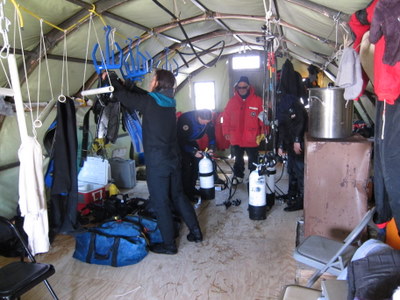
Each day they would prepare for one if not two dives. Donning multiple layers of dive underwear and dry suits, they would walk to one of our three dive holes while I hauled their tanks, weight belts, cameras, and gear bags with skidoos or a six-wheeled ATV and sleds.
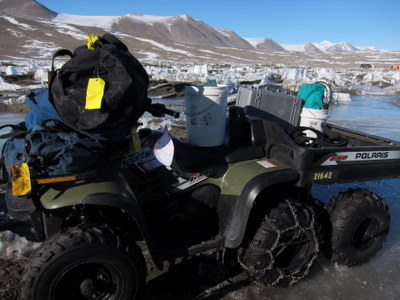
Nicknamed Circus, Side Show, and Third Ring, the holes were within 100 yards of the Jamesway and led to an amazing world of Paul’s old experiments. With no tomato or hut, the divers slid quickly and easily into holes through the 12 -18 feet of ice. Dives of 30 to 40 minutes would lead them 90 to 140 feet down to a mostly mud seafloor inhabited by a few brittle stars, scallops, and sea stars. Tough they had some camera issues, the divers took hundreds of photographs and recorded hours of video. They also found, photographed, and videoed numerous cages and floaters from Paul’s experiments from the 1980s. Lastly, they collected various specimens and an entire floater for Paul to analyze back at the lab.
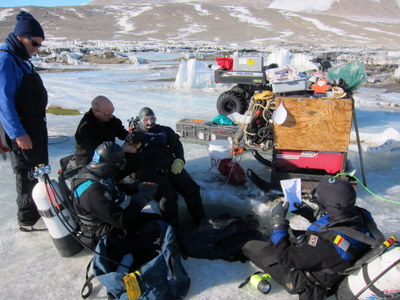
While it will take a while to fully analyze the data, Stacy already has some preliminary findings. In the past, the few researchers that had made it to this remote area of the world focused on more shallow waters due to dive limits. While Stacy was here in 2002-2004 and 2007-2010, she was diving mainly to depths of only 60 feet. Now, with numerous dives of 80-140 feet, she is seeing a greater abundance of creatures at these deeper depths than she had originally thought. She found beautiful lacy cup bryozoans that she had not expected to find here. She was also happy to learn that white sprinkles on the seafloor are actually barf piles or skeleton piles from brittle stars and sea urchins. She had seen them with SCINI in 2007 but needed to retrieve them to see what they really are. Overall, she didn’t realize there was so much predation and diversity at deep depths. What else will she learn? What else will the divers’ pictures and samples reveal about these mostly undisturbed creatures in our world?
While the SCUBASelf Contained Underwater Breathing Apparatus divers dove and recovered, the SCINI crew would be out setting up for their missions. The first step involved deploying sonar to make terrain maps of the seafloor and identify potential points of interest. A device called a scanning sonar would be lowered on a 200 foot cable to a point ten feet above the seafloor. Once down, the Marco Polo game would start. The responder would send out sounds which would bounce back at various intervals to show ridges, valleys, rocks, and, most importantly, Paul’s experiments. This information would tell the SCINI crew how far away the points of interest were but they still had to know if they were east, west, north or south of the hole. How would you do that?
The engineers’ solution was to send down a floater, sunk by a weight, in another hole at a known GPSA Global Positioning System (GPS) is a satellite-based navigation system used to track the location or position of objects on the Earth’s surface. location and at an exact measured distance away. This would allow them to orient the sonar image and, in the end, get accurate GPSA Global Positioning System (GPS) is a satellite-based navigation system used to track the location or position of objects on the Earth’s surface. coordinates of all the things they found on the seafloor so that future researchers could easily find them again.
Once mapped, the sonar image became the background for the navigation screen on which dots would then represent SCINI’s location. Called a snail trail, the dots looked like a trail of breadcrumbs and it allowed the pilots to keep track of exactly where SCINI was under the ice.
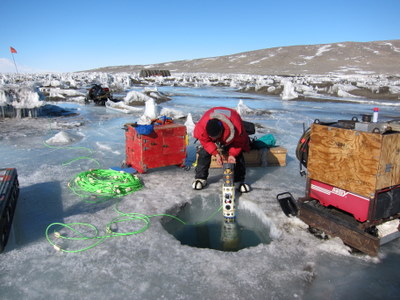
Then the three to five-hour SCINI mission could start. DJ, David, and Bob would sit in a control room with the lead scientist, Paul, and a navigator. Whoever was piloting, mostly David or DJ, would use the joystick, instrument data, control software, and live video from either the forward looking or the downward looking camera to navigate SCINI. Going deeper and on longer missions than the divers, SCINI was an invaluable asset – especially to Paul who could see the underwater world without having to face its dangers.
The navigator, Kamille or Jennifer, would watch the two monitors and annotate the beginnings and ends of transects, the location of Paul’s cages and floaters, and interesting creatures or features. All of this data was saved and backed up on multiple computers so Paul can postpone his retirement for years while he sorts through the thousands of images and notes.
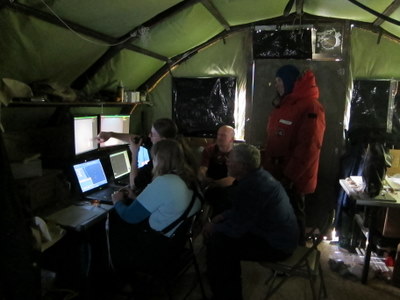
SCINI team accomplishments involve terrain maps of subsea prevalent features at depths of 100, 108, and 137 feet for all three holes – something that had never been done before in this location. The SCINI crew also got images and subsea coordinates of all of Paul’s 12 floaters in the area for further analysis and potential recovery in the future. They also found and imaged about 10 transects at the the three holes. On top of that, they photographed 30-foot transects of the seafloor in 5 to 10 foot increments from a depth of 30 feet all the way to 110 feet. This was also something new that helped Paul see comparisons between the near shore and off shore environments. According to Paul, they got a ton of data! Sorry Paul, looks like you’ll be working hard for years to come!
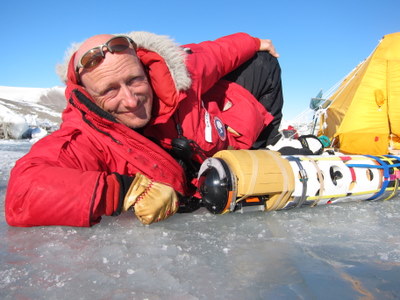
According to DJ and Bob, flying SCINI here was beautiful and fun. Because New Harbor is a little basin tucked into a cove, there is no current. This makes sonar possible and it makes flying SCINI much easier. The tether and her body doesn’t move her around as much! Bob said that when he was here with SCINI in 2007, she was still in her infancy and he was still learning how to adjust her trim and ballast. Now, though there were complications with known flooding issues, she’s dialed in and her premier at New Harbor was a complete success.
Yippeee! The divers are happy, the SCINI crew is happy, and Paul is ecstatic!
On top of that, we had a wonderful, beautiful time at New Harbor. The weather was warm with windless, cloudless days - only blue, sunny skies so that we wore our Little Reds more than Big Reds! Food, though lacking in freshies and fruit, was delicious and home-made, tailored for the vegetarians and lactose intolerant members of our groups. The coffee connoisseurs had their morning supplies, the chocoholics had brownies and cake, and for the meat eaters we even had a real turkey dinner one night.
Though we were out in an utterly breathtaking, MartianPertaining to or like the planet Mars.-like landscape in one of the most remote places in the world, we were not lacking anything - other than maybe a shower!
Which, not that we are back in McMurdo, we all got last night! Now it’s back to the comforts of diving from huts on the ice and the luxury of dorm rooms with real mattresses. We’re back to food prepared for us by the galley crew, a seemingly endless supply of drinking and cleaning water, and toilets which simply involve 1 seat!
Enjoy the comforts of your home and life as we continue our work here – 1 month to go. Don’t forget to register for Wednesday’s 4:30 (PST) Webinar. (http://iceaged2010.mlml.calstate.edu/events/)
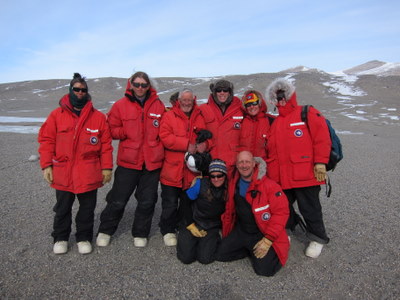


Comments